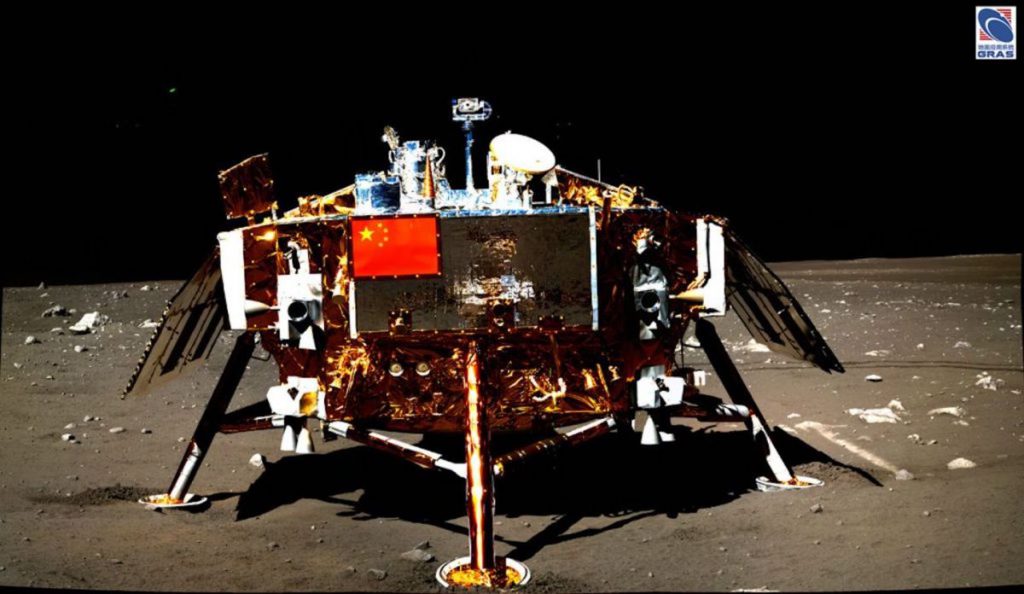
Next China moon mission will need precision landing to target ice at south pole (Image Credit: Space.com)
China is developing a set of robotic spacecraft to land on the moon and join other countries in the search for water at the lunar south pole.
The Chang’e 7 lunar mission is planned to launch around 2024 and will survey the moon from orbit while also landing at and exploring the lunar south pole.
“A major goal is to find water at the south pole of the moon,” Wu Weiren, chief designer of China’s lunar exploration program, told China’s CCTV during the country’s annual political sessions in early March. “There are deep lunar craters at the south pole, which cover about 10 kilometers [6 miles]. If there was water, it could exist in the form of water ice due to the lack of sunlight throughout the year.”
Related: China’s Chang’e 5 lunar lander is first to find water on the moon up close
Wu said engineers are developing a special spacecraft that could detach from a lander and fly or hop to survey nearby craters in search of traces of water ice, China Daily reported.
A competitive call to Chinese institutes to develop payloads for Chang’e 7 issued by the China National Space Administration’s (CNSA) Lunar Exploration and Space Engineering Center in 2020 revealed that the mission will consist of five spacecraft: an orbiter, a relay satellite, a lander, a rover and a “mini flying craft” that will carry the instrument to detect water.
The presence of water ice around the lunar south pole was confirmed in 2018, and hopes of using that water to supply astronauts and fuel rockets is a major factor in NASA’s plan to set up its Artemis Base Camp at the lunar south pole.
Artemis 1, a mission soon to be launched by NASA’s monster Space Launch System (SLS) rocket that recently rolled out in Florida, will carry Lunar Flashlight, a suitcase-sized satellite, among its many payloads. The spacecraft will shine infrared lasers into permanently shadowed craters near the lunar poles while orbiting the moon to improve scientists’ understanding of the quantities and accessibility of water ice.
However, setting down at the south pole of the moon will bring challenges for China and its Chang’e 7 mission, including identifying landing sites and making an accurate landing. Chang’e 7 requires a “high precision of landing, since there are not many flatlands at the south pole,” Wu told CCTV. “After our preliminary analysis, probably only one-tenth of the area can be used as the landing point. Therefore, the landing could be quite difficult.”
The mission is far from being a one-off, with repeated visits and a possible permanent base among China’s plans, which build on a series of lunar missions over the past 15 years. The country approved a three-stage lunar program in the early 2000s: first the Chang’e 1 and Chang’e 2 orbiters; then landers and rovers with Chang’e 3 and Chang’e 4, with the latter making the first-ever landing on the lunar far side in early 2019; then Chang’e 5, which completed a complex sample-return mission in late 2020.
The success of these missions and renewed international interest in the moon paved the way for the new round of missions, with Chang’e 7 part of a new, fourth phase of Chinese lunar missions.
“Chang’e 7 is mainly for the survey of lunar resources, such as water, the environment and climate, topography and landform of the lunar south pole,” Wu said.
Next, Chang’e 6, originally planned as a backup to the Chang’e 5 mission, will attempt to collect samples from the lunar south pole and deliver them to Earth.
Chang’e 8 will then test technologies such as in-situ resource utilization, oxygen extraction and 3D printing on the moon. The technologies will need to be verified in preparation for a future lunar base.
“We hope to analyze and study the existence of resources on the spot, which will lay the foundation for long-term work on the moon in the future,” Wu said of Chang’e 8. “So the utilization of resources is particularly important. The timeline for the mission is stated vaguely as being “before 2030.”
Following this, China and Russia intend to establish a robotic research station, the International Lunar Research Station, which will later host astronauts for long-term stays. The two countries have also invited international partners to join the project, with particular interest in attracting those in Europe. However, with Russia’s invasion of Ukraine, such cooperation looks doubtful.
Follow us on Twitter @Spacedotcom and on Facebook.





